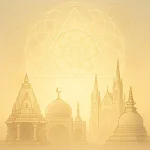The Sacred Geometry in Religious Architecture
Since ancient times, human beings have sought to express the divine through art, design, and structure. Among these expressions, one of the most profound and mysterious is sacred geometry — the use of specific shapes, proportions, and mathematical principles believed to reflect the order of the universe and the mind of the Creator. Across cultures and centuries, from Hindu temples to Islamic mosques, from Gothic cathedrals to Buddhist stupas, sacred geometry has served as a silent yet powerful language of spirituality.
The Universal Language of Geometry
Geometry, at its core, is the study of patterns, proportions, and relationships — the same qualities that underlie both nature and spirituality. In religious architecture, geometry is more than design; it becomes a symbol of divine harmony. Circles, triangles, squares, and spirals are not merely shapes — they represent universal truths.
For instance, the circle often symbolizes eternity and perfection because it has no beginning or end. The square stands for stability and the material world, while the triangle is often used to represent balance, divinity, or the connection between heaven and earth. When these forms combine in precise mathematical ratios, they create not just visual beauty, but also a sense of spiritual alignment that invites contemplation and peace.
Hindu Temples – The Cosmic Blueprint
In Hinduism, sacred geometry forms the very foundation of temple design. The Vastu Purusha Mandala, a geometric diagram, is the core plan behind most Hindu temples. It represents a cosmic being lying within a square — symbolizing the universe itself. Every element of a Hindu temple, from the towering shikhara (spire) to the inner sanctum, is aligned according to this geometric pattern.
This arrangement is not random; it mirrors the cosmic order described in ancient Hindu scriptures. When devotees enter a temple built on these proportions, they symbolically journey from the outer, chaotic world toward the inner sanctum — the place of spiritual stillness and divine union. Thus, sacred geometry in Hindu architecture becomes a pathway to the divine.
Islamic Architecture – The Infinite through Patterns
Islamic art and architecture are renowned for their mesmerizing geometric designs. Because Islamic tradition discourages figurative depictions of God, geometry became a means of expressing the infinite nature of the divine. Repeating star patterns, tessellations, and interlaced polygons in mosques and madrasas are not mere decoration — they are acts of devotion.
For example, the Alhambra in Spain and the Blue Mosque in Turkey display intricate geometric tilework that symbolizes infinity, unity, and the perfection of God’s creation. The balance and symmetry in these designs reflect the belief that everything in the universe follows a divine mathematical order. The observer, when gazing upon such patterns, is invited to meditate on the infinite wisdom and unity of Allah.
Christian Cathedrals – Geometry of Light and Divinity
In medieval Europe, Christian architects used sacred geometry to design Gothic cathedrals that embodied the connection between heaven and earth. The proportions of these cathedrals were based on precise ratios like the Golden Ratio (1:1.618), believed to reflect divine beauty.
The cross-shaped floor plans, pointed arches, and rose windows were not only architectural innovations but also spiritual symbols. The geometry of the rose windows, for instance, represents the harmony of creation and the light of God illuminating the world. The cathedral’s towering spires draw the eyes upward — urging the soul to ascend toward the divine. In this way, sacred geometry transformed stone and glass into a living prayer of light.
Buddhist and Other Traditions – Circles of Enlightenment
In Buddhism, sacred geometry appears most clearly in the mandala, a circular diagram symbolizing the universe. The design of stupas — dome-shaped monuments — is also deeply geometric, with every angle and curve representing stages of enlightenment. Similarly, in Native American, Egyptian, and Mayan architecture, geometric symbolism was used to connect earthly existence with celestial order.
The mandala, when visualized or built, becomes a tool for meditation, guiding the practitioner through layers of reality toward ultimate truth. The geometry itself is believed to hold energy — aligning mind and matter with the cosmic whole.
The Spiritual Power of Proportion
What unites all these architectural traditions is a shared belief: geometry reflects the divine order of creation. When a space is built on these sacred proportions, it resonates with the same mathematical harmony found in nature — from the spirals of galaxies to the petals of a lotus.
Standing inside such spaces, one often feels an unexplainable peace. This is not coincidence; sacred geometry creates balance between the physical and the spiritual. It reminds us that the universe itself is not chaos, but an ordered expression of divine intelligence.
The Architecture of the Soul
Sacred geometry in religious architecture is far more than art or engineering; it is a spiritual science — a way to make the invisible visible. Whether it is the shining diya in a temple, the patterned tiles of a mosque, or the stained glass of a cathedral, all point to the same truth: God is geometry made manifest.
Through these timeless forms, humanity continues to express its yearning for the divine — building not just temples and mosques, but bridges between heaven and earth.
~Religion World Bureau









